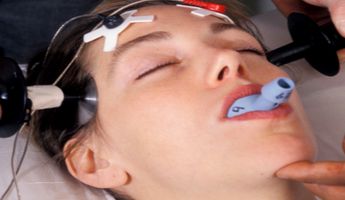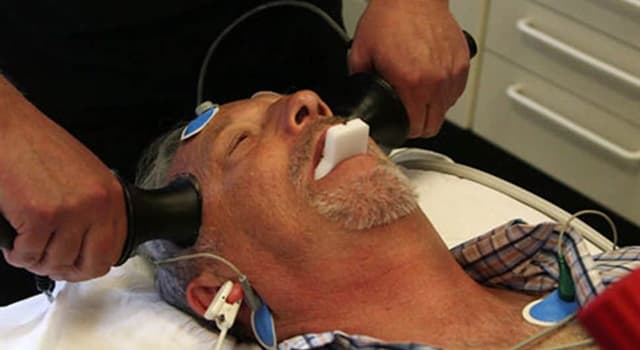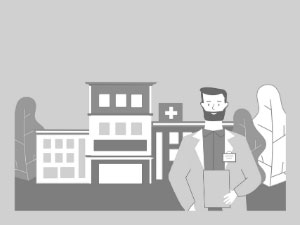Electroconvulsive Therapy (ECT) in Lithuania
Search and Compare the Best Clinics and Doctors at the Lowest Prices for Electroconvulsive Therapy (ECT) in Lithuania

Find the best clinics for Electroconvulsive Therapy (ECT) in Lithuania
No clinics available

- Home
- Lithuania
WHY US?
At Medijump, we're making medical easy. You can search, compare, discuss, and book your medical all in one place. We open the door to the best medical providers worldwide, saving you time and energy along the way, and it's all for FREE, no hidden fees, and no price markups guaranteed. So what are you waiting for?

Free

Best Price

Widest Selection

Risk-Free
What you need to know about Electroconvulsive Therapy (ECT) in Lithuania

Electroconvulsive therapy (ECT) is a procedure that involves passing a carefully controlled small electric current through the brain to trigger a brief seizure. It causes changes in brain chemistry and aims to relieve severe psychiatric conditions.
ECT is usually performed when other treatments are unsuccessful. It is usually used to treat:
-
Treatment-resistant depression, which is a severe depression that does not improve with medications or other types of treatments.
-
Severe depression, especially when accompanied by psychosis (detachment from reality), a refusal to eat, or a desire to commit suicide.
-
Severe mania that can occur as parts of bipolar disorder, such as a state of intense euphoria, hyperactivity, agitation, impaired decision-making, and psychosis.
-
Agitation and aggression in individuals with dementia.
-
Catatonia, which is associated with schizophrenia, certain other psychiatric disorders, or medical illness.
Your doctor may also recommend ECT if you cannot tolerate medications or all other forms of therapy have not worked.
What is the cost of Electroconvulsive Therapy (ECT) in Lithuania?
When computing the final cost of the Electroconvulsive Therapy (ECT) in Lithuania, it's crucial to consider the multiple elements that factor into the total fee. The cost isn't exclusively limited to the procedure's price but involves the count of sessions needed, the fee for the anesthesiologist, costs for pre-surgery tests, charges for the facility, and the pricing for extra medicines to be used.
Getting a pricing quote from a preferred clinic is an ideal first step towards quantifying the cost, as they can give a more precise breakdown aligned to your personalized necessities and situations. While the Electroconvulsive Therapy (ECT) might inflict substantial financial strain, it's important to evaluate the cost against the prospective advantages. Fast alleviation of severe symptoms, shortened hospital stays, and less use of health services owing to failed treatment trials, all contribute towards the overall cost-efficiency of this medical procedure.
What does the Procedure Involve?
At the beginning of an ECT, you will receive general anesthesia and a muscle relaxant to help prevent injury and minimize the seizure. Your doctor will place a blood pressure cuff around one of your ankles to stop the muscle relaxant medications from entering foot and entering the muscles there. This is done to enable your doctor to monitor seizure activity by watching for any movement on that foot. You may also be given oxygen through an oxygen mask and a mouth guard to help protect your tongue and teeth from injury. Then, your doctor will place electrode pads on your head. The electrode pads are connected to the ECT machine.
Once you are asleep, your muscles are relaxed, and the necessary equipment is in place, your doctor will press a button on the ECT machine to pass a small amount of electric current through the electrodes to your brain, which produces a seizure that lasts less than 60 seconds. Due to the anesthetic and muscle relaxant, you will not be aware of the seizure. The visible effects of the seizure will usually be limited to the movement of your foot if a blood pressure cuff is placed around your ankle.
Your doctor may use a test called an electroencephalogram (EEG) to record the electrical activity in your brain. The beginning of a seizure is signaled by sudden, increased activity on the EEG and a leveling off shows that the seizure is over.
How Long Should I Stay in Lithuania?
ECT can be performed on an outpatient basis, meaning you can leave the hospital on the same day. However, the length of your stay in Lithuania while undergoing a Electroconvulsive Therapy (ECT) is largely determined by your personal health state and the number of treatment sessions proposed by your healthcare provider. Treatment typically involves two to three sessions per week, accumulating to six to twelve sessions in total.
Commonly, you would be required to reside in the Lithuania throughout the course of the treatment. The total duration not only factors in the treatment sessions but also the requisite rest time post-treatment, typically a couple of hours for the anesthesia effects to dissipate after each session. Moreover, you might need to consider post-treatment consultations for tracking progress and if required, revisions to the treatment plan. Because of these factors, you might want to plan on staying in the Lithuania for several weeks. Yet, it's highly advised to confer about the specific timeframe and aftercare process with your healthcare professional to ensure a comprehensive understanding and effective treatment path.
What's the Recovery Time?
Most people can return to their normal daily activities just a few hours after ECT. However, some people may be asked to avoid making important decisions, going back to work, or driving for one to two weeks following the last ECT treatment in a series. The recovery time until you can resume your activities generally depends on when confusion and memory loss after the procedure are resolved, so make sure to talk to your doctor about your specific recovery timeline.
What About Aftercare?
Here are a few aftercare instructions you need to consider:
-
Your doctor may give you antidepressants to help decrease or prevent symptoms of depression. They may also give you medicine to help with headaches that you may experience after each treatment. Always make sure to take the medicine as directed.
-
There is a high chance that you will fall after ECT treatments. Ask someone to help you stand up or walk and keep an eye on you during your recovery period.
What's the Success Rate?
Research has shown that ECT is a highly effective therapy for several mental health conditions. Around 80% of patients with uncomplicated but severe depression experience substantial improvement after their treatments.
ECT is a highly misunderstood procedure because, in the past, the side effects can be severe. However, while ECT does have some side effects and risks, it is much safer today. The risks and side effects include confusion, memory loss, adverse reaction to anesthesia, increased blood pressure and heart rate, headache, nausea, and muscle ache.
Are there Alternatives to Electroconvulsive Therapy (ECT)?
Below are some of the alternatives to ECT:
-
Transcranial Magnetic Stimulation (TMS) involves using rapidly alternating magnetic fields to stimulate specific areas in the brain. It is often used to treat depression.
-
Vagus Nerve Stimulation (VNS) was initially developed to treat seizure disorders, but it can also be used to treat depression. In this procedure, an electric pulse generator is implanted under your skin to stimulate the vagus nerve in the neck.
What Should You Expect Before and After the Procedure
Prior to the Electroconvulsive Therapy (ECT), your medical professional will provide you with comprehensive instructions relating to preparations, such as dietary guidelines and adjustments to your medication. A detailed psychiatric and medical examination will also be performed, encompassing various tests such as blood work, an ECG, and potentially a full physical evaluation, to confirm your physical health and suitability for the procedure. Furthermore, having a trustworthy support network is key to accompany you to the medical facility, offer emotional comfort, and assist in managing your aftercare.
Post the Electroconvulsive Therapy (ECT), your condition will be closely observed in a recuperation area. You might feel befuddled, lose your sense of direction, or struggle with memory loss immediately, however, these reactions are short-term and usually disappear within an hour. Once your condition stabilizes, you can safely return home under the guardianship of another person as your cognitive and motor abilities might be momentarily affected.
Before ECT, you may have a certain mental health condition and experience severe symptoms that are thought to be life-threatening or they do not improve after other treatment options. After the treatment, you may notice an improvement in your symptoms, which may take around six weeks.
What are Potential Risks of Electroconvulsive Therapy (ECT)?
Generally, the Electroconvulsive Therapy (ECT) is considered safe, but as with all medical procedures, it has potential hazards. Typical side effects are headaches, muscular discomfort, queasiness, and upchucking, which usually diminish swiftly with rest and medication. More severe hazards include possible health complications like cardiac issues, predominantly in individuals with existing heart diseases. Moreover, some patients may exhibit temporary disorientation right after the procedure, but this usually resolves within an hour. They might also have difficulties recollecting events that happened shortly before the treatment or in the weeks or months leading up to the treatment.
Risks associated with the procedure are usually reduced through a comprehensive pre-procedure assessment, encompassing a detailed medical history, physical examination, and diagnostic testing.
Whilst the information presented here has been accurately sourced and verified by a medical professional for its accuracy, it is still advised to consult with your doctor before pursuing a medical treatment at one of the listed medical providers
No Time?
Tell us what you're looking for and we'll reachout to the top clinics all at once
Enquire Now

Popular Procedures in Lithuania
Prices Start From $28

Prices Start From $20

Prices Start From $28

Prices Start From $32

Recommended Medical Centers in Lithuania for procedures similar to Electroconvulsive Therapy (ECT)

- Interpreter services
- Translation service
- Religious facilities
- Medical records transfer
- Medical travel insurance
- Health insurance coordination
- TV in the room
- Safe in the room
- Phone in the room
- Private rooms for patients available

- Interpreter services
- Translation service
- Religious facilities
- Medical records transfer
- Medical travel insurance
- Health insurance coordination
- TV in the room
- Safe in the room
- Phone in the room
- Private rooms for patients available

- Interpreter services
- Translation service
- Religious facilities
- Medical records transfer
- Medical travel insurance
- Health insurance coordination
- TV in the room
- Safe in the room
- Phone in the room
- Private rooms for patients available

- Interpreter services
- Translation service
- Religious facilities
- Medical records transfer
- Medical travel insurance
- Health insurance coordination
- TV in the room
- Safe in the room
- Phone in the room
- Private rooms for patients available

- Interpreter services
- Translation service
- Religious facilities
- Medical records transfer
- Medical travel insurance
- Health insurance coordination
- TV in the room
- Safe in the room
- Phone in the room
- Private rooms for patients available

- Interpreter services
- Translation service
- Religious facilities
- Medical records transfer
- Medical travel insurance
- Health insurance coordination
- TV in the room
- Safe in the room
- Phone in the room
- Private rooms for patients available

- Interpreter services
- Translation service
- Religious facilities
- Medical records transfer
- Medical travel insurance
- Health insurance coordination
- TV in the room
- Safe in the room
- Phone in the room
- Private rooms for patients available

- Interpreter services
- Translation service
- Religious facilities
- Medical records transfer
- Medical travel insurance
- Health insurance coordination
- TV in the room
- Safe in the room
- Phone in the room
- Private rooms for patients available

- Interpreter services
- Translation service
- Religious facilities
- Medical records transfer
- Medical travel insurance
- Health insurance coordination
- TV in the room
- Safe in the room
- Phone in the room
- Private rooms for patients available

- Interpreter services
- Translation service
- Religious facilities
- Medical records transfer
- Medical travel insurance
- Health insurance coordination
- TV in the room
- Safe in the room
- Phone in the room
- Private rooms for patients available
Electroconvulsive Therapy (ECT) in and around Lithuania
About Lithuania
Lithuania is an Eastern European country and is the largest and most populous of the three Baltic States. The country has a population of 3 million people, capital and largest city is Vilnius. There are only 3 Hospitals in Lithuania that are JCI accredited and all 3 can be found at the capital.
Lithuania welcomes an ever-increasing number of medical tourists each year, many of which travel for Electroconvulsive Therapy (ECT) procedures. The biggest attraction of Lithuania has to be the cost. Once you are there it is very affordable to eat, drink and get around and the prices from private clinics for medical treatment are extremely competitive. Come from within Europe on a low-cost airline and you will probably pay for your treatment and your holiday for less than your procedure would have cost at home.
Popular Parts of Lithuania
Although Lithuania is one of the lesser known countries of Europe, the country is actually a beautiful destination. Lithuania is home to incredible castles, lakes, forests, and landscapes.
- Vilnius: The capital of Lithuania is a city of churches. It is a dreamy city especially under the golden glow of summer sun. The city is often referred to as one of the cheapest city breaks in Europe. Trendy bars, hills, beautiful architecture, and fascinating history all makes this city an amazing destination. Hot-air balloons above Vilnius are also an impressive sight.
- Kaunas is the second city in Lithuania and is probably the coldest city in the country. Most tourists’ attractions in the city are within walking distance, making it a pleasant city to explore. The street in Old Town is packed with interesting architecture and hidden attractions.
- Druskininkai is filled with health spa amenities. Tourists will find countless natural attractions such as mineral water and curing mud. The city offers many outdoor and leisure activities such as river canoeing, cycling, adventure park with rope obstacles, and ski.
- Nida is a peaceful fishing village. It is a popular destination for tourists looking for some downtime, it has beautiful panoramic views. It is also home to the highest moving sand dunes in Europe. The Dead Dunes is probably the most famous spot in Nida.
Weather and Climate in Lithuania
Lithuania is at its best in summer when the days are warm and the Baltic Sea is swimmable. The country is swarming with tourists during this season. Summer starts from June until August; the average temperature is around 20 °C during the day and 14 °C during the night.
Spring arrives late, usually starts in April and finishes in May. Spring makes the country look even more beautiful with blossoming flowers and cherry trees. The temperature is usually cool.
Autumn has many sunny days and adds more color to the country. Autumn starts in September and lasts for two months. The nights in autumn are chilly, and the temperature usually drops to 0.1 °C in late November.
Winter is especially cold with an average temperature of around -6.6 to -2.8 °C. Some winters can be even colder with the average temperature dropping as low as -20 °C.
Getting Around in Lithuania
Vilnius International Airport is the largest airport in Lithuania. It connects the country with European cities. The airport is the hub for air Baltic and Get Jet Airlines. Budget airlines such as Ryanair and Wizz Air also operate flights from this airport. Other international airports are Kaunas International Airport, Palanga International Airport, and Šiauliai International Airport. The airports in Lithuania do not serve domestic flights.
Vilnius airport taxis are available and can be found in front of the arrivals terminal. The taxis are comfortable and affordable. All taxis accept payment by cash or credit card, a journey to the city center should cost around 10 EUR to 18 EUR. The city bus is a more cost-effective option to travel to Vilnius. A single ticket costs 1 EUR and can be purchased on the bus.
Getting around in Lithuania by car is the best way if you wish to visit many destinations. Lithuanian roads are among the best in Eastern Europe. The country has four-lane highways connecting Vilnius, Kaunas, Klaipeda, Panevėžys, and Palanga.
Intercity buses dominate the system of Lithuanian public transportation. Buses link all major cities and smaller towns. Buses between big cities are very frequent and usually leave every 15 minutes. Bus tickets can be purchased in the bus station or directly from the bus driver. Trains in Lithuania are good value but rather slow. Riding a bicycle is a nice way to get around inside the cities. Most roads are kept in good condition. Bike hire is available across all major cities and several small villages.
Tourist Visas in Lithuania
Citizens of the European Union, the United States, Canada, Australia, and Britain are granted visa-free entry to Lithuania and may stay for up to 90 days. Other foreign nationals must apply and obtain a visa before entering Lithuania. It is advisable to contact the local embassy to check visa requirements for Lithuania.
Lithuania is part of the Schengen Area, those who already have a Schengen visa do not have to apply for a new visa to enter Lithuania. A passport valid for at least three months beyond the length of stay is required by all visitors.
Additional Information
- Local Currency: The local currency is the euro. Lithuania adopted the euro in 2015. 1 USD is equivalent to 0.88 EUR.
- Money & Payments: ATMs are available in cities and towns, even in small villages. Most banks will exchange your money, but the easiest way is to withdraw cash from an ATM. Most restaurants and hotels accept credit cards (mostly Visa, MasterCard, and American Express). Always make sure to carry cash for small purchases such as museums and markets. Tourists can tip 10% in restaurants, always tip with cash even if you’re paying by credit or debit card. Taxi drivers do not expect a tip, but it is common to add a couple of euros.
- Local Language: Lithuanian is the official language. English is widely spoken by younger generations. The older generations usually only have very basic English skills. Most people know Russian or at least very basic Russian. Polish is also understood in certain areas. German is also spoken in Palanga, Neringa, and other major cities.
- Local Culture and Religion: The predominant religion in Lithuania is Christianity; with around 77% of the population is Catholic. There are also small groups of Jews, Muslims, as well as other faiths.
- Public Holidays: As a Christian country, Lithuania celebrates Christian religious holidays such as Easter, Christmas Eve and Christmas. Lithuania has little traditions to celebrate its national patriotic holidays. The country hosts many annual and unique festivals all-year round. Galapagai Rock Music Festival in July, Palanga Smelt Festival in February, Vilnius Festival in June, Trakai Middle Age Festival in June, and Vilnius Film Festival in late March to early April.
Popular Searches
- Plastic Surgery in Thailand
- Dental Implants in Thailand
- Hair Transplant in Thailand
- Breast Augmentation Thailand
- Gastric Sleeve in Thailand
- Gender Reassignment Surgery in Thailand
- Laser Hair Removal in Bangkok
- Botox in Bangkok
- Dermatology in Bangkok
- Breast Augmentation in Bangkok
- Coolsculpting in Bangkok
- Veneers in Turkey
- Hair Transplant in Turkey
- Rhinoplasty in Turkey
- Stem Cell Therapy in Mexico
- Rhinoplasty in Mexico
- Liposuction in Mexico
- Coolsculpting in Tijuana
- Rhinoplasty in Korea
- Scar Removal in Korea
- Gastric Sleeve in Turkey
- Bone Marrow Transplant in India
- Invisalign in Malaysia
- Plastic Surgery in the Dominican Republic
- Tummy Tuck in the Dominican Republic
- Plastic and Cosmetic Surgery in Poland
- Rhinoplasty in Poland
- Hair Implant in Poland
- Dental Implants in Poland
- IVF in Turkey